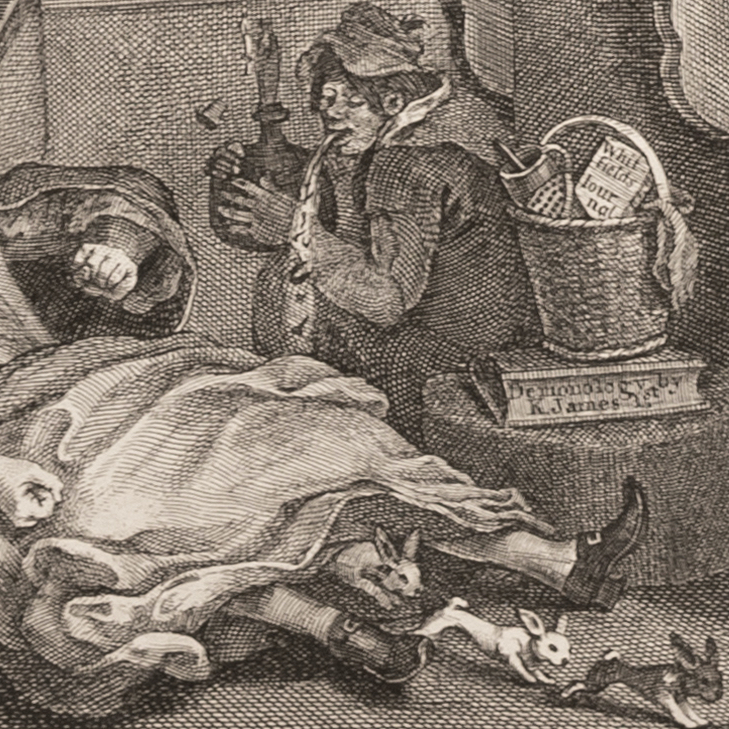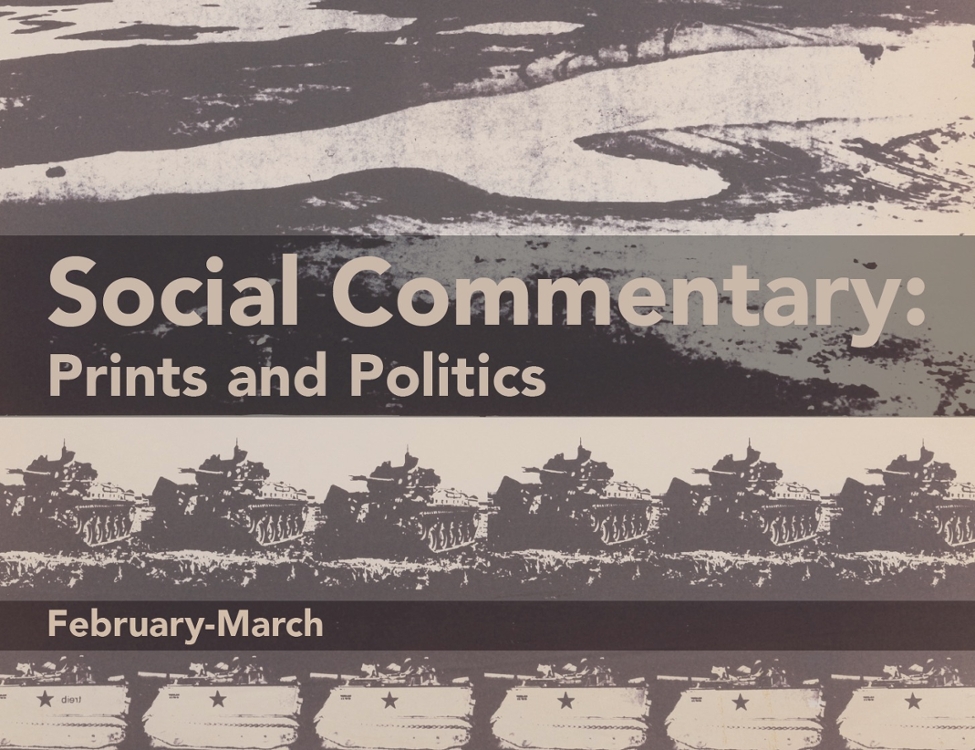Prints and Politics
 Kiki Smith, "Still," 2006, etching/spit bite/aquatint/softground/hardground.
Kiki Smith, "Still," 2006, etching/spit bite/aquatint/softground/hardground. Judy Chicago, "Peeling Back," 1974, lithograph.
Judy Chicago, "Peeling Back," 1974, lithograph. Winslow Homer, "The Inauguration of President Lincoln," 1861, wood engraving.
Winslow Homer, "The Inauguration of President Lincoln," 1861, wood engraving. William Strang, "Doings of Death - Death on the Barricades," 1901, two-tone woodcut.
William Strang, "Doings of Death - Death on the Barricades," 1901, two-tone woodcut. Carita Kent (Sister Mary), "Go Slo, Luke 2:14-51," 1963, serigraph.
Carita Kent (Sister Mary), "Go Slo, Luke 2:14-51," 1963, serigraph. Salvador Dalí, "Lincoln in Dalivision," c.1976, serigraph/intaglio/embossing.
Salvador Dalí, "Lincoln in Dalivision," c.1976, serigraph/intaglio/embossing. Richard Hamilton, "Kent State," 1970, serigraph.
Richard Hamilton, "Kent State," 1970, serigraph. Patti Warashina, "Eye of the Storm," 2006, monoprint.
Patti Warashina, "Eye of the Storm," 2006, monoprint. Kara Maria, "Paradise," 2002, monoprint/chine-collé.
Kara Maria, "Paradise," 2002, monoprint/chine-collé. Art Hazelwood, "Pillars of Society" from Pillars of Society Portfolio, 2007, linocut.
Art Hazelwood, "Pillars of Society" from Pillars of Society Portfolio, 2007, linocut. Art Hazelwood, "Liberty Lost" from Pillars of Society Portfolio, 2007, linocut.
Art Hazelwood, "Liberty Lost" from Pillars of Society Portfolio, 2007, linocut. Art Hazelwood, "Slaughter of the Innocents" from Pillars of Society Portfolio, 2007, linocut.
Art Hazelwood, "Slaughter of the Innocents" from Pillars of Society Portfolio, 2007, linocut. Art Hazelwood, "Sower" from Pillars of Society Portfolio, 2007, linocut.
Art Hazelwood, "Sower" from Pillars of Society Portfolio, 2007, linocut. Art Hazelwood, "The Voice of the People" from Pillars of Society Portfolio, 2007, linocut.
Art Hazelwood, "The Voice of the People" from Pillars of Society Portfolio, 2007, linocut. Sarah Whorf, "The Price of Light," 2010, linocut.
Sarah Whorf, "The Price of Light," 2010, linocut.Printmaking has been connected to activism and politics from its inception. This tradition is alive and well today, as printmakers use their art to deepen the conversation about social justice and so much more. As MoMA suggested in a 2016-2017 exhibition From the Collection: 1960-1969, political prints have acted “both as urgent responses and imagined possibilities, showing what the world is and what it could be.” On the one hand, as demonstrated by the 1970 Berkeley political posters included in this exhibition, “printmaking possesses the unique ability to disseminate information camouflaged as art. Innately more egalitarian and accessible, and therefore less precious and valuable, the production of prints is often a community activity that can also easily enter the public sphere” (Jessica Caponigro). On the other hand, this exhibition includes print artists whose work makes deeply personal, political, dramatic, and urgent statements about the causes and consequences of justice and injustice in our world that are not predicated on a quick process or large edition number to ask pressing and provocative questions of the audience.
Throughout history, political printmakers have experimented with creating art for wider and narrower audiences, and with creating art that upholds or challenges the status quo. William Hogarth, the eighteenth-century painter and printmaker included in this exhibition, provides a good illustration of an artist pulled in these different directions, but over the course of his career his art became both more “public” and more critical of the power structures in his world. Hogarth, however, was culturally conservative, and his art was primarily critical of the unwelcome changes that he perceived in England and London. The artists whose work features above, however, are attuned to identifying and explaining social injustices, and advocating for change. Corita Kent (1918-1986), a Roman Catholic nun, used her art to advocate for social justice, and her work became increasingly activist “throughout the ‘60s…urging viewers to consider poverty, racism, and injustice.” The print by Richard Hamilton, a prominent practitioner of the British Pop Art Movement, was inspired by the violence against student protesters at Kent State, and connects directly to the posters from the Berkeley Political Print Workshop. For other artists included, the use of art to provoke reflection and action is central to their practice. For example, Art Hazelwood has regularly used “art as a means of educating society about complex social issues,” including advocacy for the homeless, the incarcerated, and work that draws attention to student debt. His portfolio of five linocut prints “Pillars of Society” (2007) was inspired by German artist George Grosz’s critique of Weimar-era corruption in a painting of the same title (1926). As Hazelwood noted, “art can be about an engagement in the moment; not just an ironic distance from world events, but an actual exploration of what is going on in the world…for me, that is what art is all about.” Hazelwood – along with the other artists featured in this exhibition, like Kiki Smith, Kara Maria, Judy Chicago, and others – is thoroughly situated in socially engaged practices, and challenges viewers to become activists.
Today more than ever, because of Black Lives Matter and contemporary social justice movements, printmakers are at the forefront of political art in 2021. There are many groups of artists who have organized in support of Black Lives Matter and other social justice causes, including Black Women of Print, Printers Without Margins, and Prints for Protest which includes a “diverse group of artists and activists who share the belief that art can be used as a tool for political activism and resistance.” The artists in the Prints for Protest group explain that “we engage with an impetus for art-making rooted in the intersecting social, political, cultural, and personal realities of the everyday. This creative call to action exists within an extensive lineage of art for social change challenging oppression, injustice, violence and inequality.” The anti-racist and social justice work of today’s printmakers is catalogued in a number of places, including The Print Center’s “Social Justice Resources,” and Evan Laudenslager and Ksenia Nouril’s “Anti-Racist Print and Printmaking Resources.”
Additional Resources:
“Anti-Racist Print and Printmaking Resources” (Google Doc)
Center for the Study of Political Graphics
“Ink | Political Art for a Contentious Time,” Art 21 Magazine
“Kiki Smith: The Body As Political Battleground,” New York Times
Paper Politics: Socially Engaged Printmaking Today (2011, PM Press)
“Pressing the issue: Art Hazelwood's imagery and action on the homeless front”
“Printmaking for a Social Movement,” PBS
Printers Without Margins, Pickwick Independent Press
“Social Justice Resources,” The Print Center and International Print Center New York





